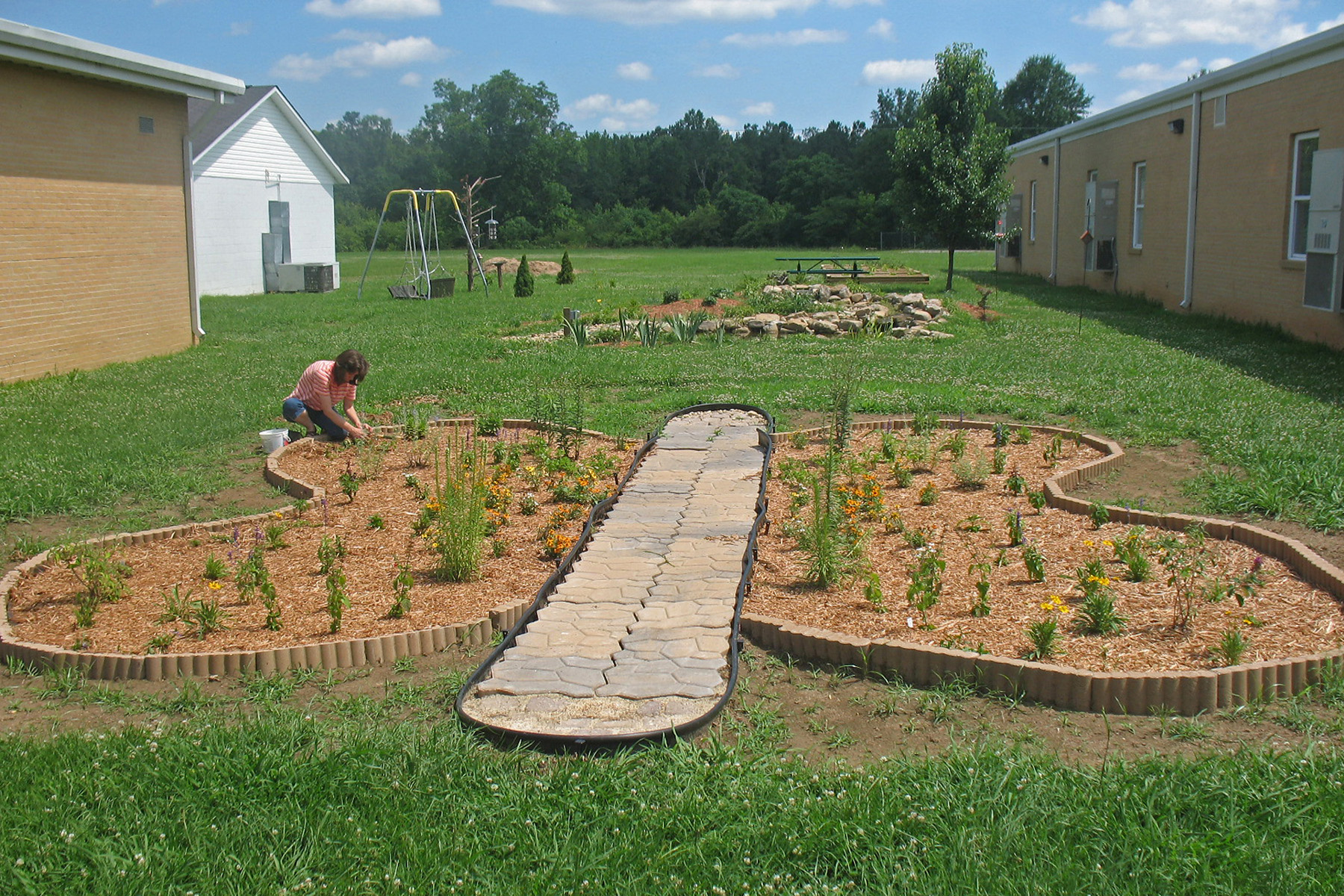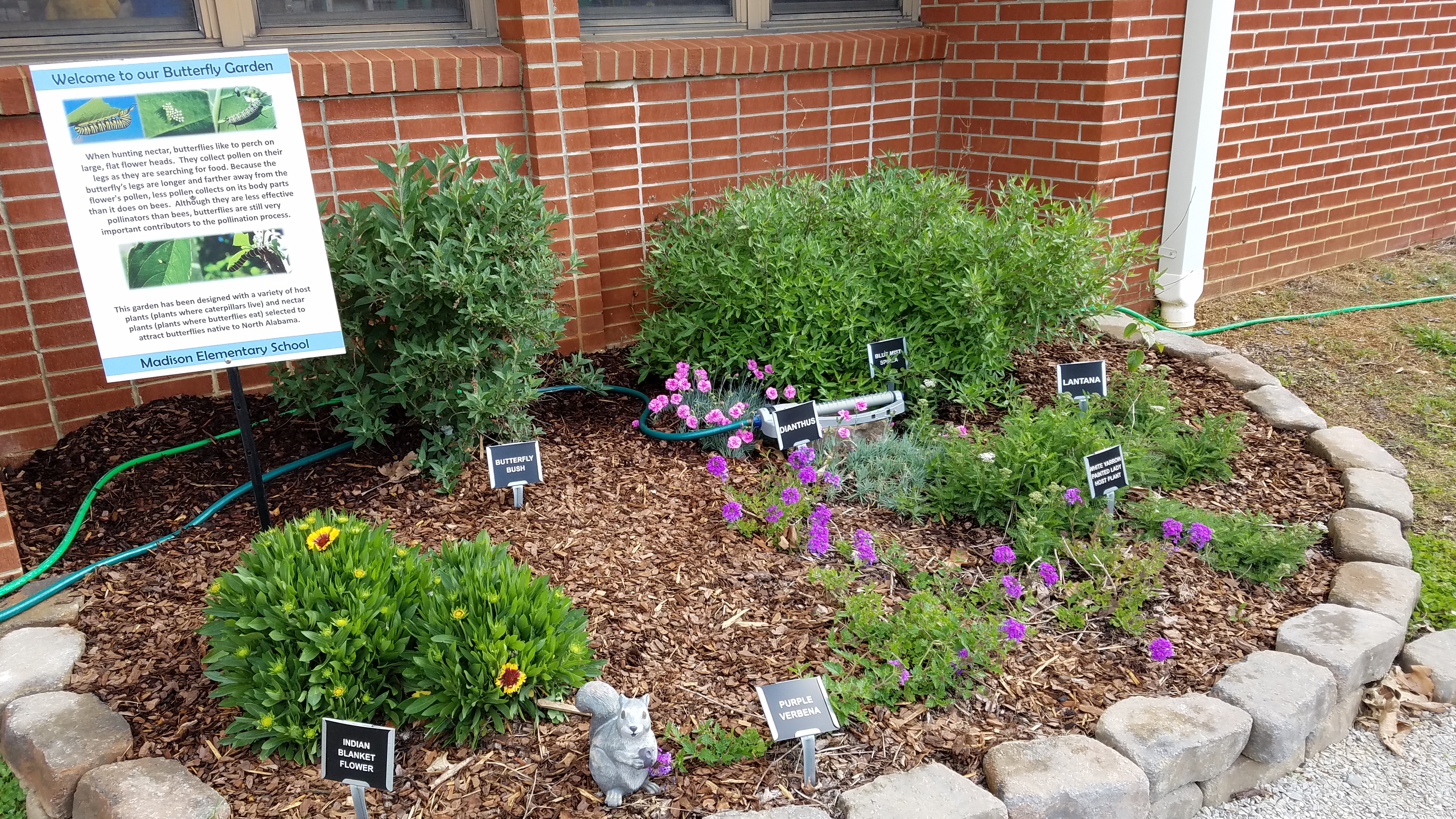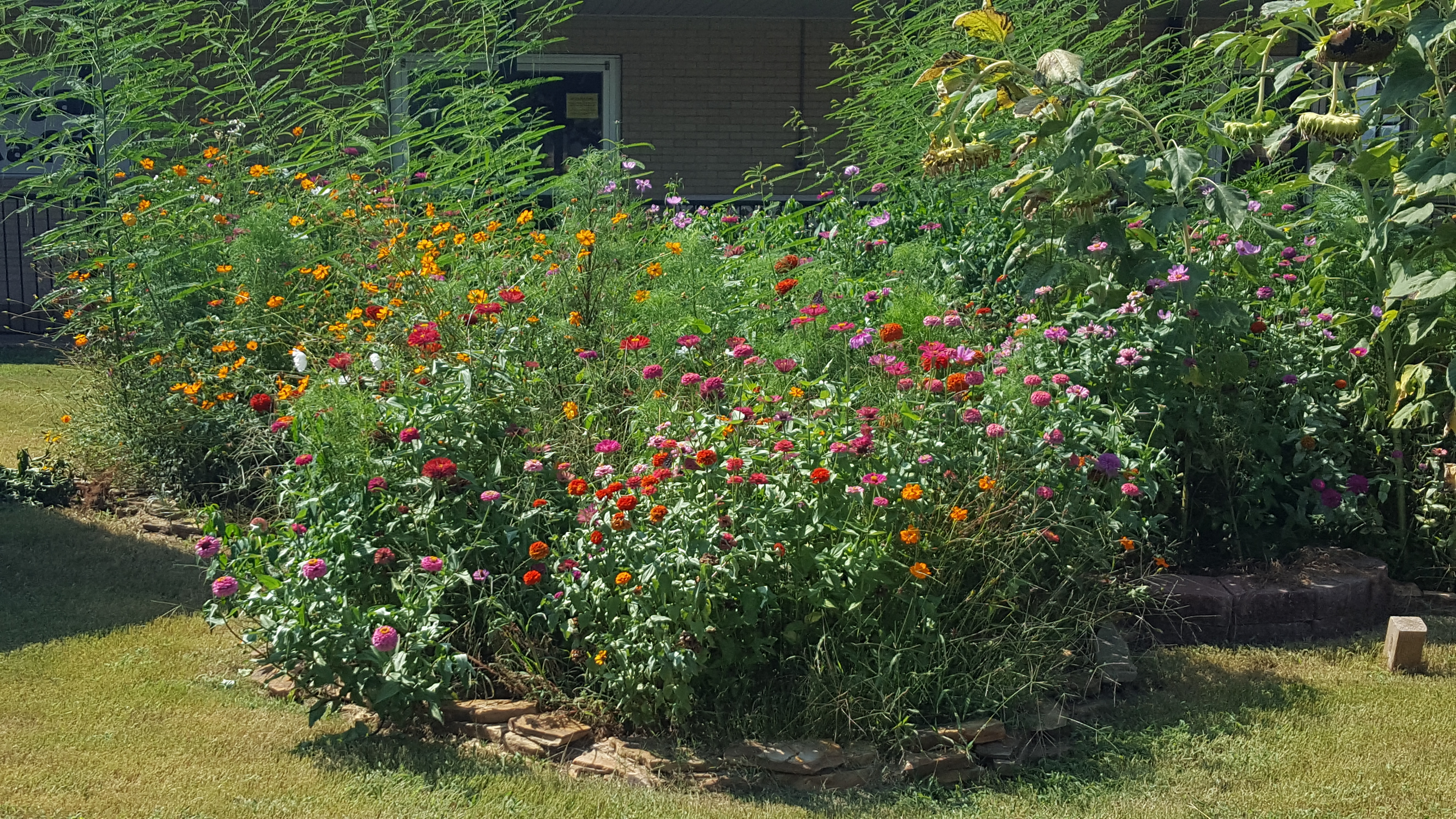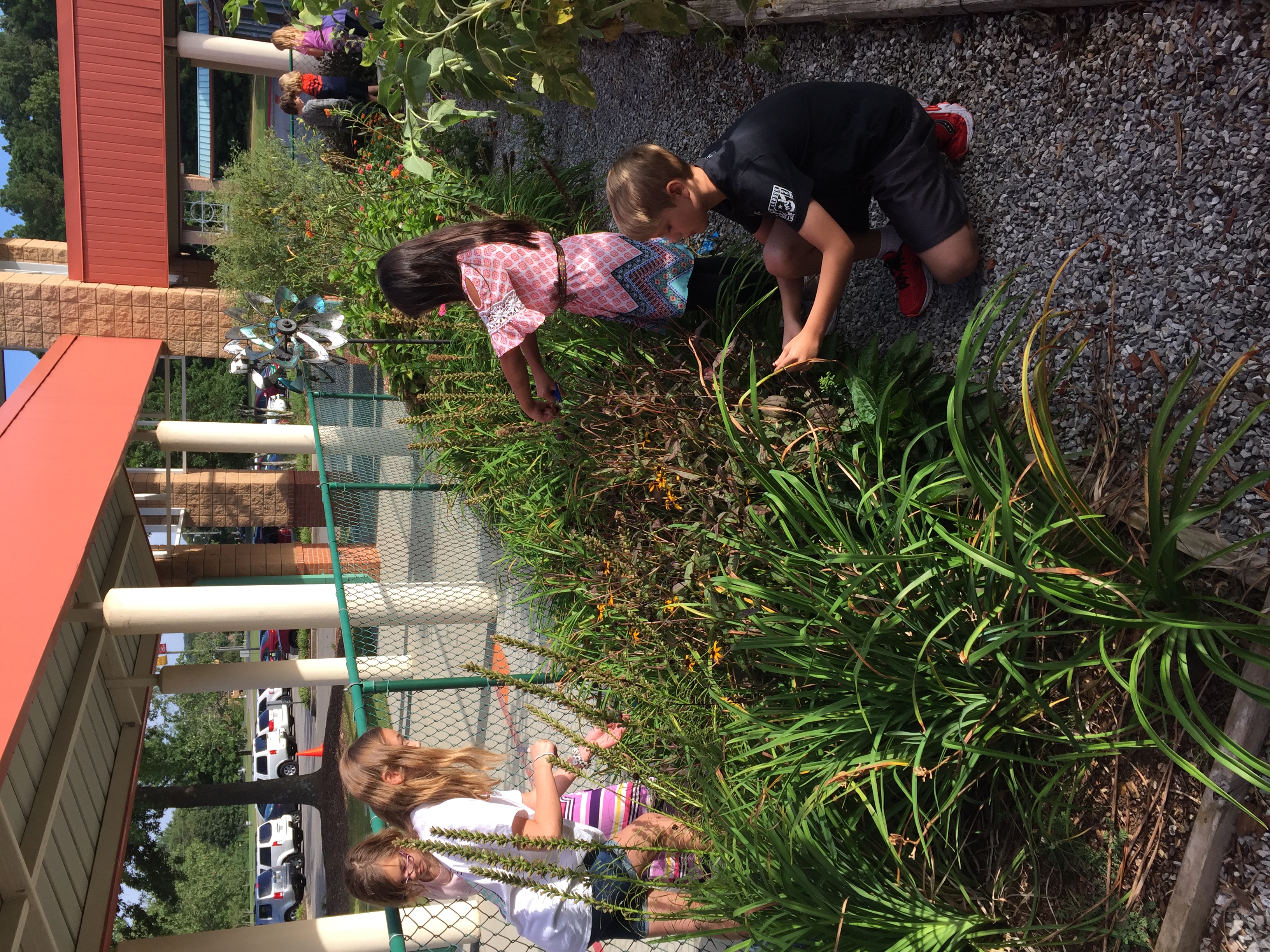Outdoor Learning Station: Butterfly Habitat
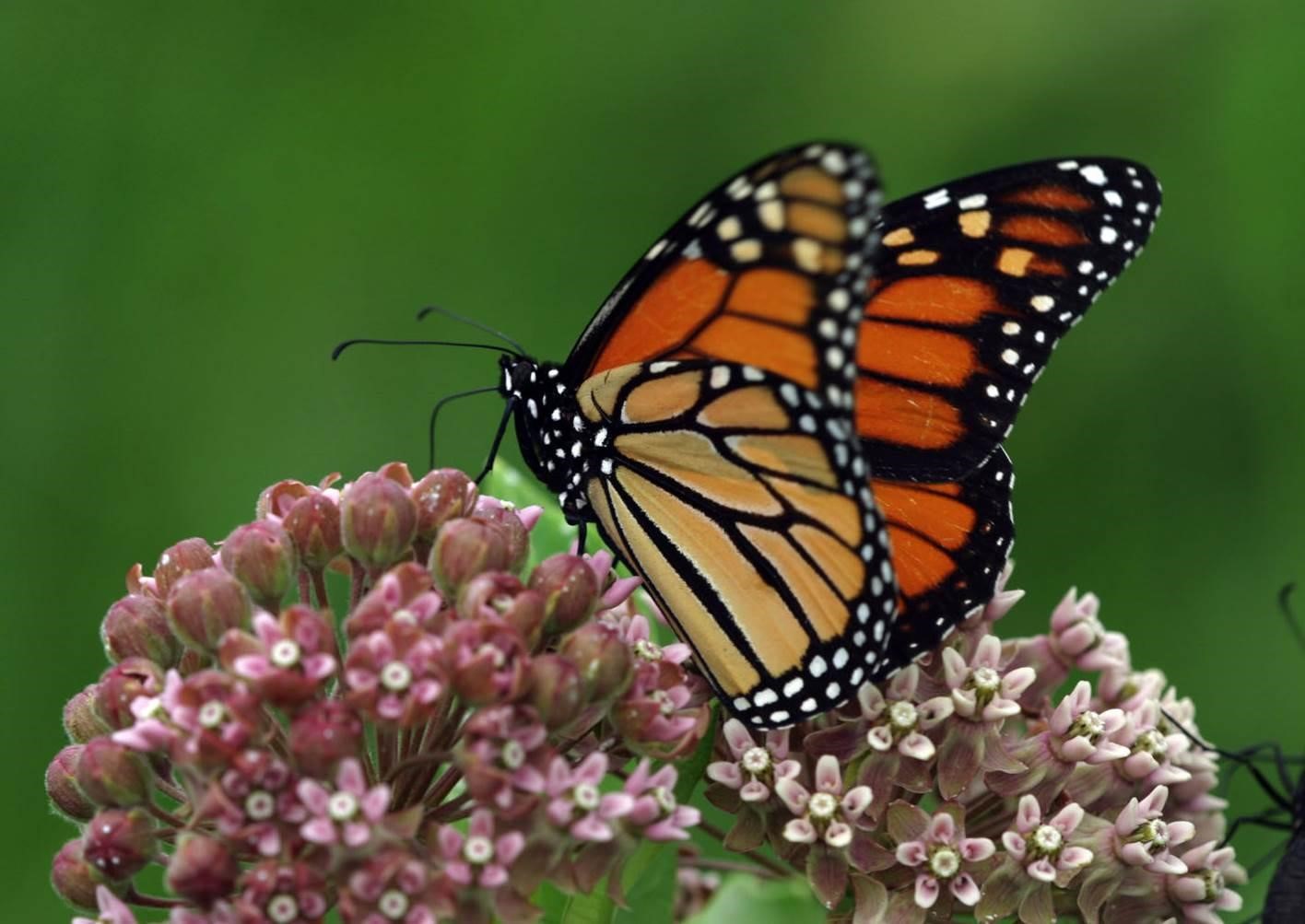 Children of all ages enjoy watching butterflies flitter from flower to flower. A butterfly garden attracts butterflies for your students to observe and study by providing habitat including food, water and shelter for all four life cycle stages of butterflies:
Children of all ages enjoy watching butterflies flitter from flower to flower. A butterfly garden attracts butterflies for your students to observe and study by providing habitat including food, water and shelter for all four life cycle stages of butterflies:1) egg
2) larva or caterpillar
3) chrysalis
4) butterfly
Below is information that will help you build and maintain your butterfly garden and use it as an educational tool:
Habitat Suggestions | Materials Budget | Plants & Plant ID Signs | Construction Instructions | Educational Sign & QR Code | Activity Resources | Maintenance Tips | Example Photos
Butterfly Habitat Suggestions
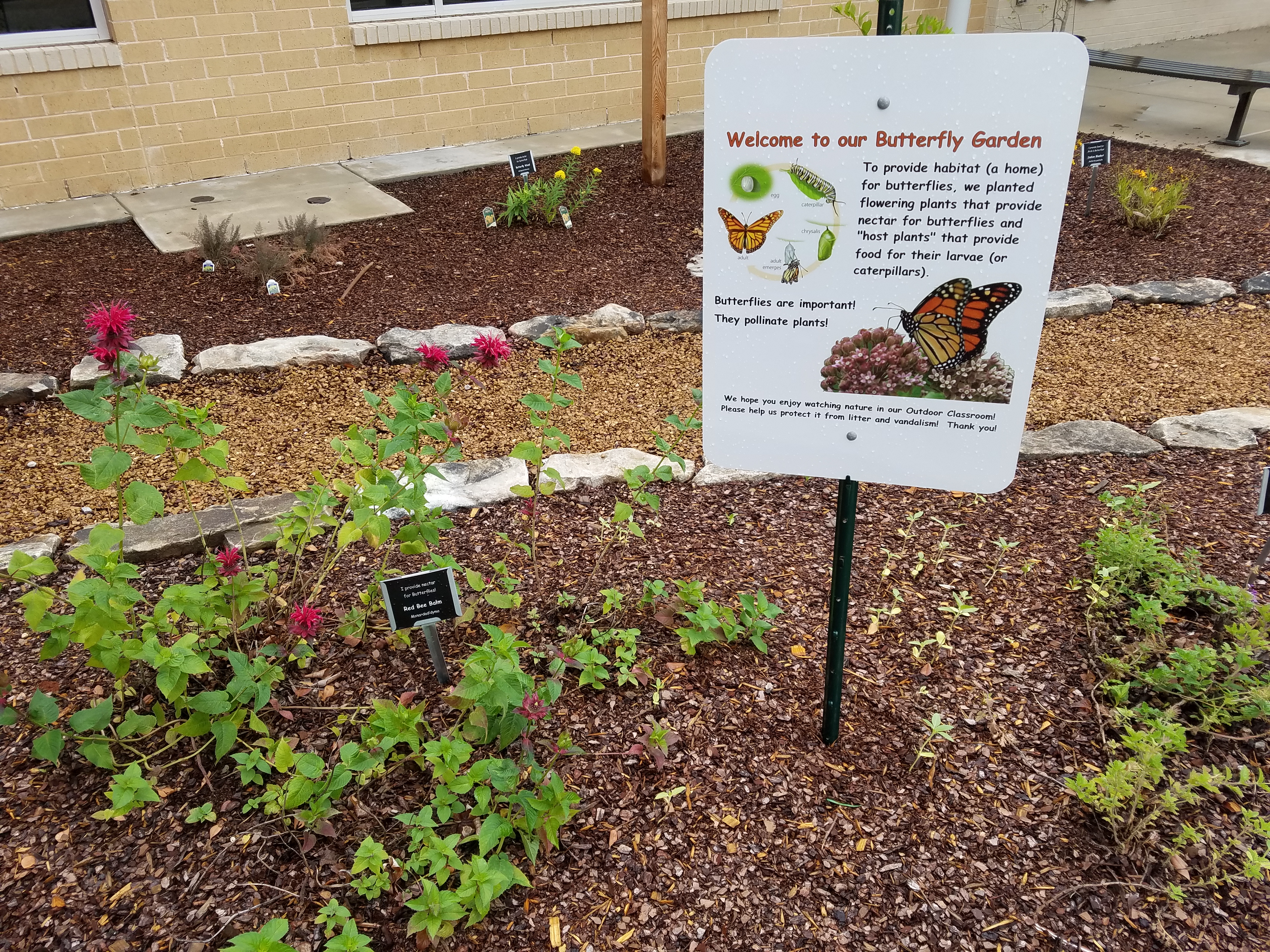
Butterflies will utilize flowering wildflowers, bushes and trees for their food source, nectar, and some will acquire their mineral needs drinking around decomposing plants or animals or around animal dung. Butterflies also get their water needs met by drinking nectar and visiting shallow puddles. Different species of butterflies only lay their eggs on specific species of plants (referred to as “host plants”) and the caterpillars will only eat these plants before creating a chrysalis to go through metamorphosis into an adult butterfly. Butterflies typically take refuge from inclement weather or predators in bushes or trees.
Habitat Requirements:
- Native flowering wildflowers, bushes and trees that produce nectar
- Native “host plants” that caterpillars eat
- Puddling stations for butterflies that prefer to get their nutrition from dung covered in sand
- Bushes and trees for cover from inclement weather and predators
- Dark colored stones where butterflies can warm up
- Full sun for 6-8 hours per day for optimal plant growth
Materials Budget
These free Materials List and Budget documents include location suggestions, materials lists, estimated budgets, and native plant suggestions:
- Standard Butterfly Garden (Word Doc | PDF)
- Butterfly-shaped Butterfly Garden (full project plan) (Word Doc | PDF)
Plant Suggestions & Plant ID Signs with QR Codes
- *Plants with *asterisk* have customized plant identification signs with unique scannable QR Codes linked to Student Exploration webpages on AWF's website that includes a description of the plant, photos of the plant, maintenance tips, and the ecological benefits that species provides.
- Plants that are bolded are NATIVE to Alabama and provide the best food sources for our native wildlife.
- All of these plants are perennials and should return in the spring after dying back in the winter.
- Visit the Alabama Butterfly Atlas website at for additional nectar and host plant suggestions (see chart below for some suggestions).
| Nectar Plants | Nectar Plants | Nectar Plants | Host Plants for Caterpillars |
| *Bee Balm | *Indian Blanket | *New England Aster | *Blue False Indigo |
| *Beeblossom | *Joe-pye Weed | Pincushion | *Butterfly Milkweed |
| *Black-eyed Susan | *Lanceleaf Tickseed | *Purple Coneflower | *Common Milkweed |
| *Blue or Pink Sage | *Lobed Tickseed | *Red Sage | *Common Yarrow |
| *Cardinal Flower | *Lavender | *Rose Vervain | *Fennel |
| *Dense Blazing Star | Mexican Petunia | *Russian Sage | *Passionflower Vine |
| Dianthus | *Miss Huff Lantana | *Stokes Aster | |
| Great Blue Lobelia | *Narrowleaf Sunflower | *Whorled Tickseed |
| Host Plants and Nectar Plants for Common Alabama Butterflies |
||
| Butterfly Species | Host Plant | Nectar Plant |
| Swallowtails | ||
| Pipevine Swallowtail | Pipevine | blueberry, blackberry, butterfly weed, butterfly bush, lilac, red bud, verbena |
| Black Swallowtail | parsley, dill, fennel, Queen Anne’s Lace, celery, carrots | red clover, butterfly weed, thistle |
| Spicebush Swallowtail | spicebush | blueberry, blackberry, butterfly weed, butterfly bush, lilac, red bud, verbena |
| Giant Swallowtail | trees and shrubs of the citrus family, hop tree, prickly ash, rue | lantana, azalea, bougainvillea, goldenrod, butterfly bush, dianthus |
| Eastern Tiger Swallowtail | sassafras, wild cherry, sweet bay, tulip tree, birch, ash, cottonwood, willow | wild cherry, butterfly bush, lilac, phlox, dianthus |
| Brush-footed Butterflies | ||
| Monarch | butterfly weed and other milkweeds | nectar from all milkweeds, lilac, clover, lantana, thistle, goldenrods, blazing stars, coreopsis, butterfly bush, and mints |
| Painted Lady | thistle, white yarrow, daisy, hollyhock, mallow | aster, cosmos, blazing stars, coreopsis, joe-pye weed, red clover, butterfly bush, zinnia, privet, butterfly weed |
| Viceroy | willows, poplars, cottonwoods, apple | aster, goldenrod, joe-pye weed, thistle, butterfly weed |
| Gulf Fritillary | passionflower vine | butterfly weed, black-eyed susan, thistle, verbena, vetch, joe-pye weed, passionflower vine, purple coneflower |
| Red Admiral | nettle | prefers tree sap and fermenting fruit, but will also nectar at daisy, aster, goldenrod, butterfly bush, red clover, gaillardia |
| Whites and Sulphur | ||
| Cabbage White | cabbage, broccoli | mustards, clover, asters, mints |
| Clouded Sulphur | alphalpha, clover | flower nectar of many plants including butterfly bush, cosmos and gallardia |
| Gossamer-wing Butterflies | ||
| Red-banded Hairstreak | wax myrtle, sumac, oak | yarrow, coreopsis, butterfly weed |
| Summer Azure | dogwood | most nectar producing flowers |
| Skippers | ||
| Common Checkered Skipper | globe mallows, mallow, hollyhock | aster, red clover, dianthus |
| Horace’s Duskywing | red oak, willow oak, water oak, white oak | goldenrod, peppermint |
These free Construction Instructions documents include a list of Construction Tools & Supplies for Outdoor Classroom Build Day as well as construction and planting instructions:
- Standard Butterfly Garden: 3-sided, against wall (Word Doc | PDF) 4-sided (Word Doc | PDF)
- Butterfly-shaped Butterfly Garden: (Word Doc | PDF)
Educational Sign & QR Code
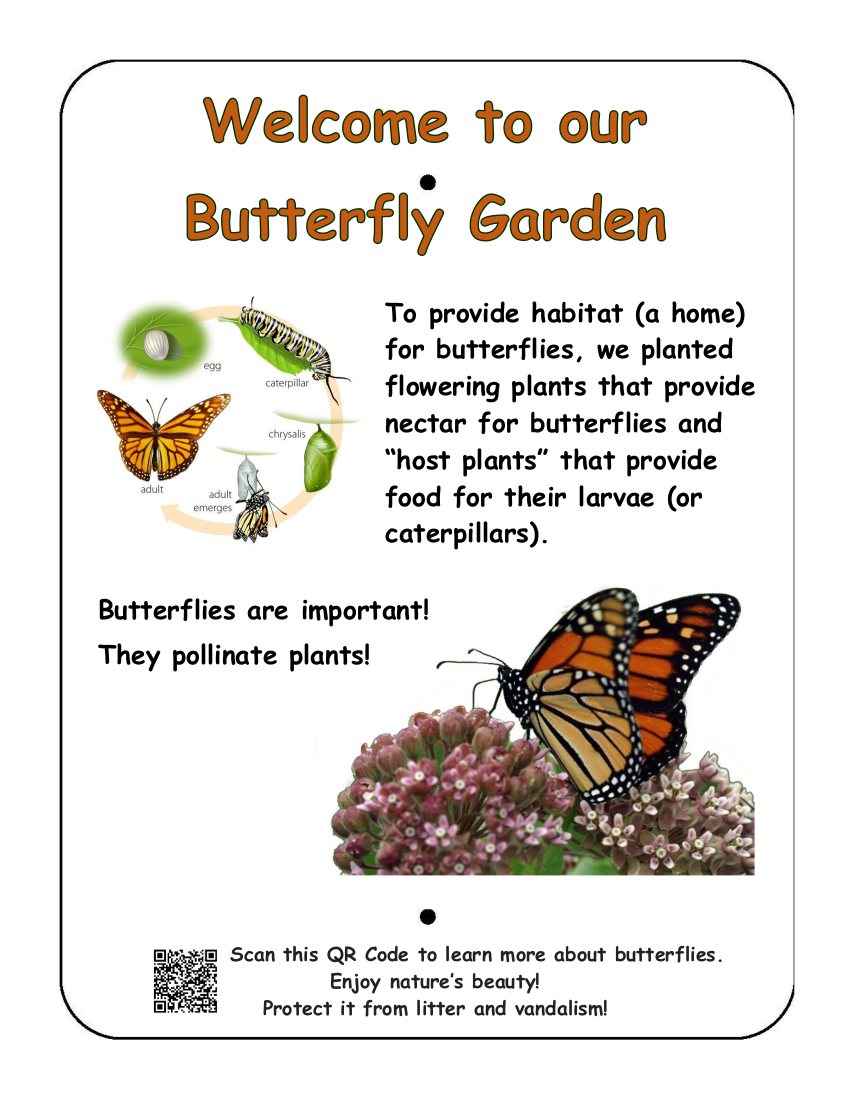
CLICK HERE to download the QR Code for this webpage.
You can inlcude the QR Code on the educational sign for your butterfly garden in your outdoor classroom: PDF | Word Doc

CLICK HERE to download the QR Code for this webpage.
You can inlcude the QR Code on the educational sign for your butterfly garden in your outdoor classroom: PDF | Word Doc
Activity Resources
The links below are to kid-friendly webpages that will help your students explore and research the habitats, plants, and wildlife in your outdoor classroom:
- Use AWF's "Learn about Butterflies and Their Habitat" webpage to help your students research butterflies including their life cycles and habitat needs.
- Use AWF's "Wonders of Wildlife" webpages to learn more about the butterflies and other animals that may be seen in your outdoor classroom.
- Use AWF's "OC Plant ID" webpages to learn more about the plants found in your butterfly garden and around your OC.
- Visit the Alabama Butterfly Atlas website for detailed information about the butterflies and moths that call Alabama home or travel through Alabama during their migration.
Below are free activity sources related to butterflies:
AWF's Outdoor Classroom Field Investigation Activities
AWF's Outdoor Classroom Field Investigation Activities
- Comparing Adult to Offspring (1st): (Version #1: Word Doc / PDF) (Version #2: Word Doc / PDF) - Students will explore the outdoor classroom as they look for animal offspring and adults of the same species, which they will compare and contrast as they record their observations.
- How Pollinators Pollinate (2nd): (Word Doc / PDF) - Students look for a pollinator in the outdoor classroom, record their observations about the pollinator, and then draw a model of the pollination process.
- Comparing Life Cycles (3rd): (Version #1: Word Doc / PDF) (Version #2: Word Doc / PDF) - Students will compare their life cycle (the life cycle of a human) with the life cycle of an animal that they find in the outdoor classroom.
AWF's Outdoor Classroom Butterfly Themed Activities
- Pasta Butterfly (Grades: K-2) - Students listen to a story about the life cycle of the butterfly, act out the life cycle stages, look for the life cycle stages in your outdoor classroom, and create the life cycle stages on paper plates using pasta and markers.
- Butterfly Book (Grades: 3-5) - Students create a butterfly book where they will keep a journal of their observations in the butterfly garden in your outdoor classroom site.
- How Many Butterflies (Grades: 3-5) - Students become "butterflies" as they look for one or more components of butterfly habitat in your outdoor classroom site during this physicallyinvolved activity.
- Butterflies without Borders (Grades: 6-8) - Students observe butterflies in your outdoor classroom site while searching for monarch butterflies, track the migration path of the monarch, and send a "Symbolic Monarch Butterfly" and letter to students in Mexico.
- Bloomin Butterflies (Grades: K-12) - Students collect butterfly eggs or caterpillars in your outdoor classroom, rear them indoors, and then release the adult butterflies in the outdoor classroom site.
- Butterfly Gardening (Grade Level: K-12) - Students will design and build a butterfly garden for your outdoor classroom site.
 Monarch Watch Program - Monarch Watch strives to provide the public with information about the biology of monarch butterflies, their spectacular migration, and how to use monarchs to further science education in primary and secondary schools.
Monarch Watch Program - Monarch Watch strives to provide the public with information about the biology of monarch butterflies, their spectacular migration, and how to use monarchs to further science education in primary and secondary schools. Maintenance Tips
To allow classes to adopt the Butterfly Garden and help take care of the plants and butterflies in this habitat, use this Learning Station Adoption Form (Word Doc | PDF), along with the maintenance tips below that include feeding and care instructions:
To create a map of the plants in your school's Butterfly Garden, use this Example Learning Station Map & Plant ID Form (Word Doc | PDF).
If your garden includes milkweed and you are having troubles with aphids, use our Tips to Control Aphids on Milkweed.
|
Carrolton Elementary Butterfly Garden |
Madison Elemenatary Butterfly Garden |
McBride Elementary Butterfly Garden |
Horizon Elementary Butterfly Garden |
Questions: Contact the AWF at oc@alabamawildlife.org.
 Wildlife Tag
Wildlife Tag
